As world politics has changed at a dizzying pace in recent weeks, Elon Musk has used fashion to reference today’s world powers by sharing a runway show featuring global political leaders and tech giants on an AI-powered virtual podium.
The SpaceX founder and Trump campaign supporter launched his fake virtual fashion show on Sunday on X, the social media platform formerly known as Twitter, which he controls and is the largest shareholder in. Pope Francis opened the digital event wearing a white Balenciaga-like puffer coat, similar to the deepfake Midjourney coat that went viral last year. The AI-generated show, which lasted just over two minutes, also featured Russian President Vladimir Putin in a rainbow strapless Louis Vuitton-inspired dress, Kamala Harris in a coconut-like bikini top and skirt printed with “Harris 2024”, and Donald Trump in an orange-striped prison jumpsuit-like lookalike with “LV” logos on the chest and dangling handcuffs.
More from WWD
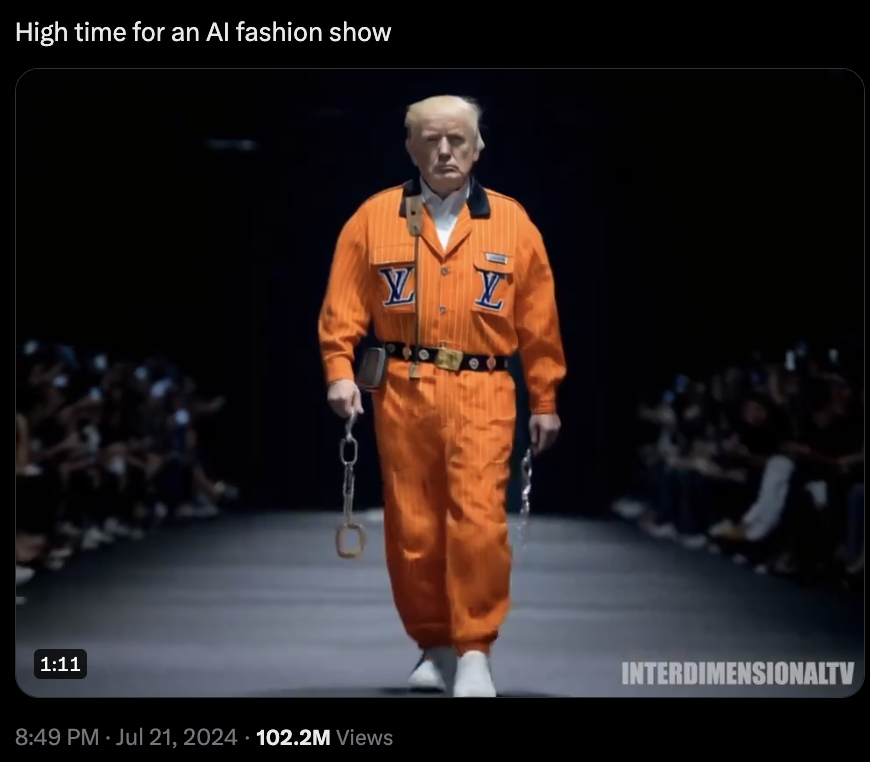

Musk has pledged $45 million to a pro-Trump PAC as the former president continues his reelection efforts. The video also features a Hillary Clinton-inspired character wearing a red pantsuit covered in what looks like “Supreme” logos (minus the second “e”); a Joe Biden-inspired character wearing aviator sunglasses and camouflage fatigues as he walks down a runway in a wheelchair; and a likeness of North Korean leader Kim Jong Un wearing a thick gold chain and a hooded jacket with images of himself and “Kim” printed across his chest. The virtual mock runway show has racked up 104.6 million views on “X.”
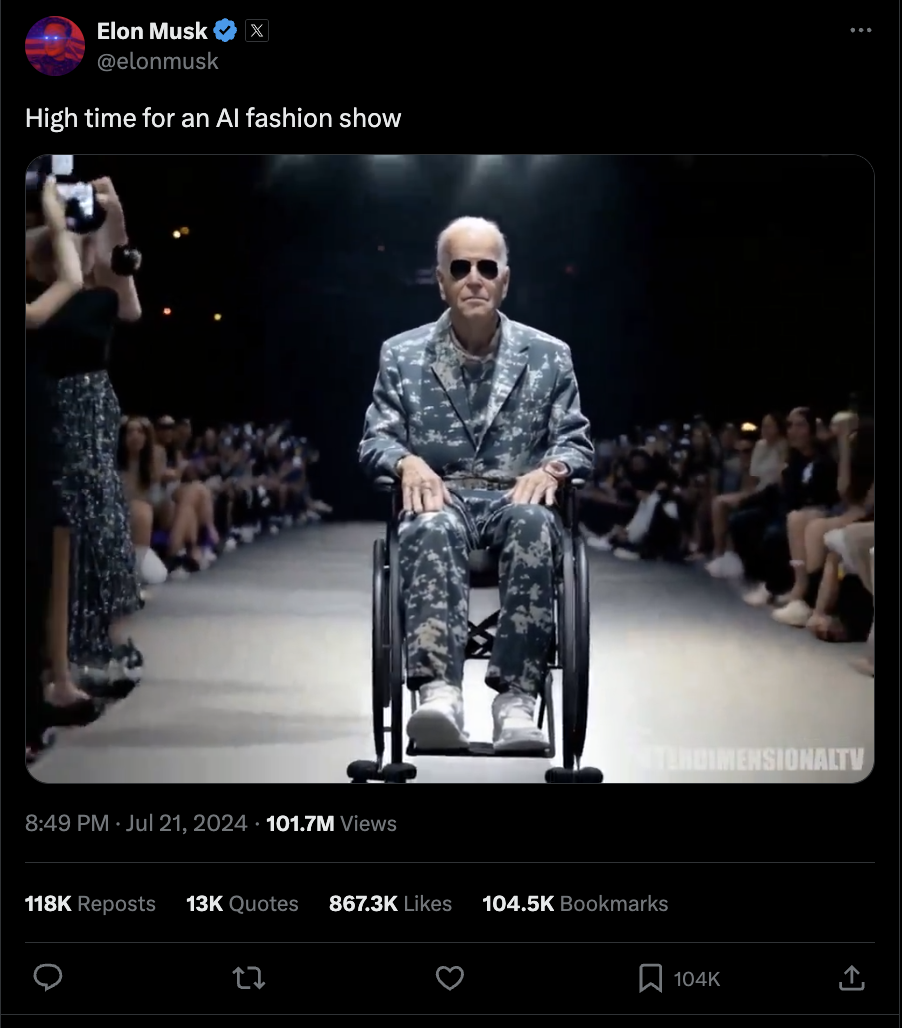

In the post, “Time for an AI fashion show,” Musk takes some aim at himself, first in a sumo wrestler outfit, then bare-chested in a black Tesla-emblazoned superhero outfit. Unlike other virtual models who only have one runway look, the character, inspired by former President Barack Obama, has 13 outfits, including two gladiator outfits that say “Hope.”
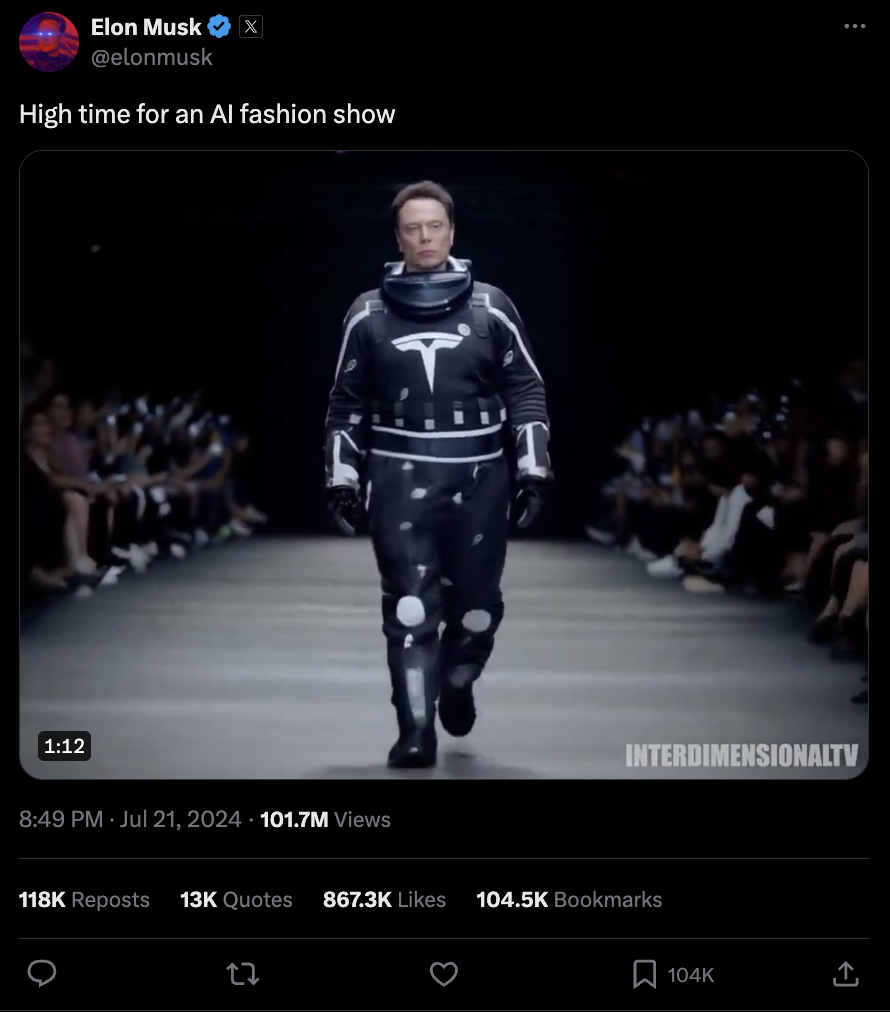

There are also AI-generated shots—or, more accurately, fakes—of Amazon CEO Jeff Bezos wearing a suit printed with banknotes and the letter “B” designed like a dollar sign; a Tim Cook avatar sports a black-topped MacBook Pro on translucent straps, an “Apple” logo belt, a black printed skirt, and a black bag; and a Mark Zuckerberg-inspired figure is seen wearing a Speedo swimsuit with the “FB” logo.
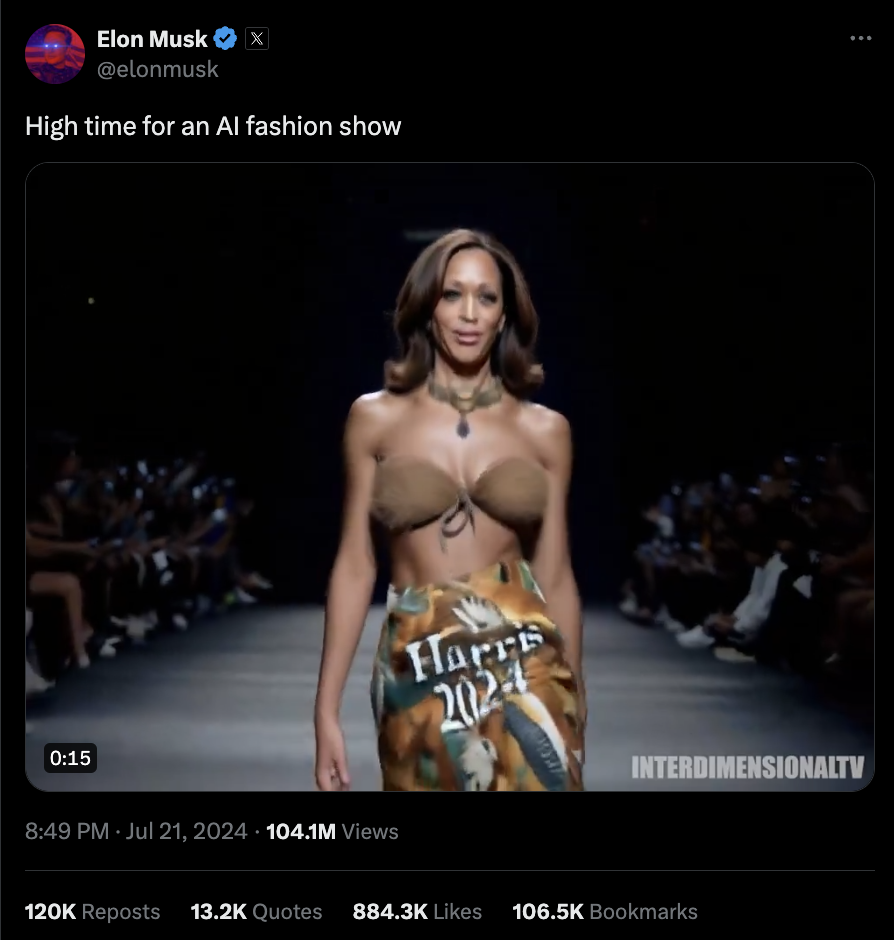

Musk is no stranger to fashion. His mother, Maye, has been a model for more than 50 years and also runs a nutrition business. The 76-year-old announced last month that she is working on four cover shoots. When asked to comment on Elon’s virtual runway show post and how fashion is being used to make politics more relatable, Maye Musk declined. Her manager, Anna Sherman, declined, saying via email, “These are not Maye’s areas of expertise.”
A spokesperson for Supreme said the company would not comment, while a spokesperson for Louis Vuitton did not respond to requests for comment Monday afternoon.
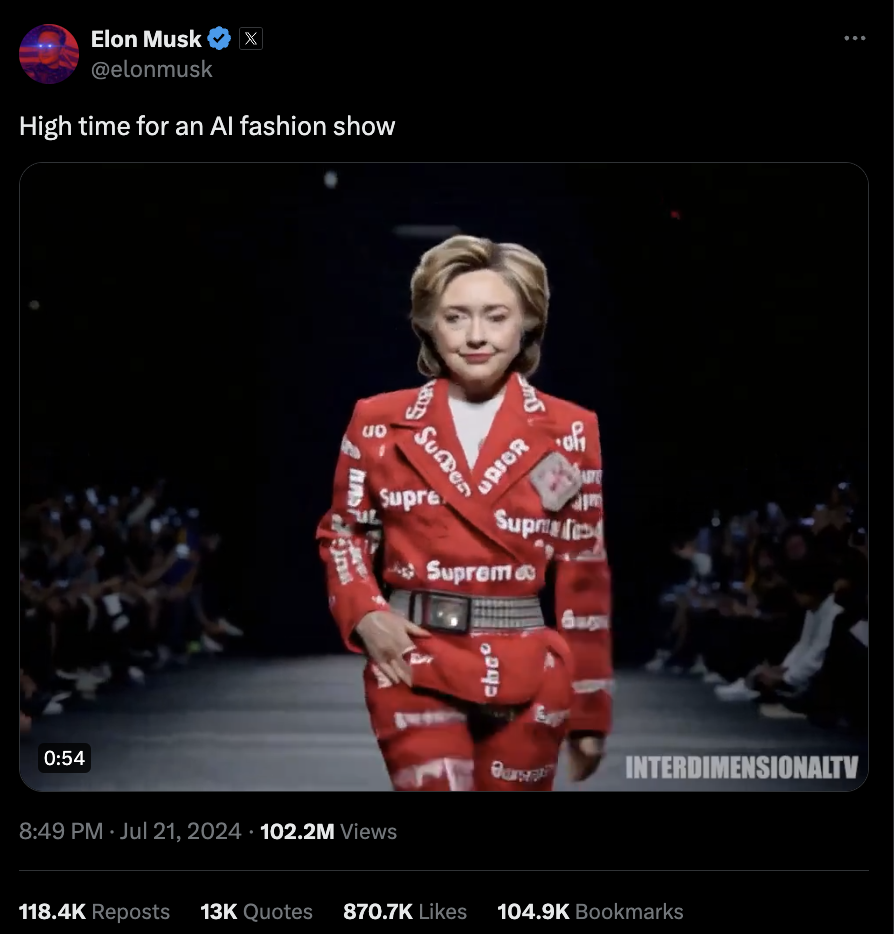

The AI-powered show highlights the “surreal intersection of politics, technology and celebrity culture,” Lynn University marketing associate professor Andrew Burnstine said Monday.
Burnstine, whose students learned about the importance of AI in fashion and marketing, said Musk’s world-leader show was reminiscent of Moschino’s “bold commentary on fashion in previous decades.” “It was a show that mixed satire, technology and cultural criticism,” he said. “Today, we’re seeing a new take on fashion through the lens of AI and advanced technology.”
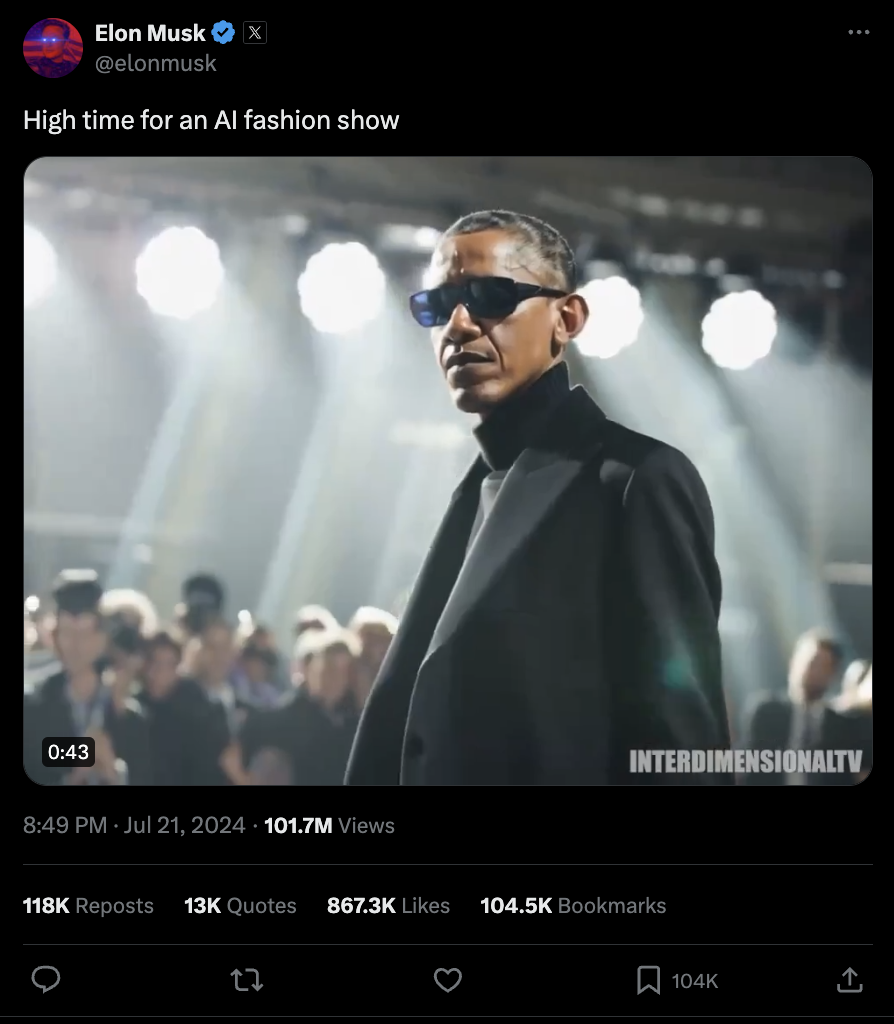

World leaders’ attire serves as “bold visual statements about their personalities and public perceptions,” Burnstine said.
Carl-Axel Wahlström, creative director at The Copy Lab, a full-service studio that uses AI imagery, described the video of the world leaders’ runway show as “a beautiful example of how generative AI can be used in a fun and creative way.” He said he hoped “people in power will be inspired and, just like superheroes, they will grab the chance to dress in ways that clearly express who they are or want to be.”
From Wahlström’s perspective, the video harkens back to the sample culture that was popular in music in the 1990s, when “technology provided new ways to reorganize brands and powerful people.” The clothing and styling in this video are also on point, he said, as hip-hop commented on the music at the time. “Fashion is fun and playful, and should always challenge styles and trends by blending ideas with new technology.”
Wahlström said he expects much of what we see in the future will involve “provocative ideas created through a mix of randomness and talent.” Like celebrities or influencers, politicians can use fashion to connect with different demographics and convey messages without words. Just as wearing casual or trendy clothing can make politicians seem “more approachable and in touch with ordinary people,” Wahlström said, embracing a variety of styles and cultural elements can allow them to “show respect and solidarity with diverse communities.” “Using fashion in this way helps to break down barriers, make politicians seem like ordinary people and create a stronger connection with the public.”
The final shot of Musk’s runway show post, featuring a Bill Clinton-like character holding up a monitor that says “Your computer encountered a problem and needs to restart,” adds, as Burnstine puts it, “a chilling reminder of AI’s pervasive presence and its capacity to both entertain and watch.” This comment highlights the dual nature of the technology: its ability to create strange and imaginative experiences, and its fundamental role in data collection and control.”
The best of WWD